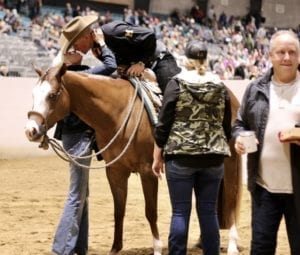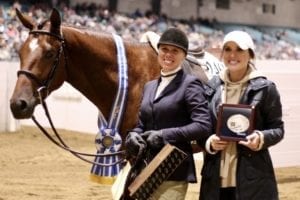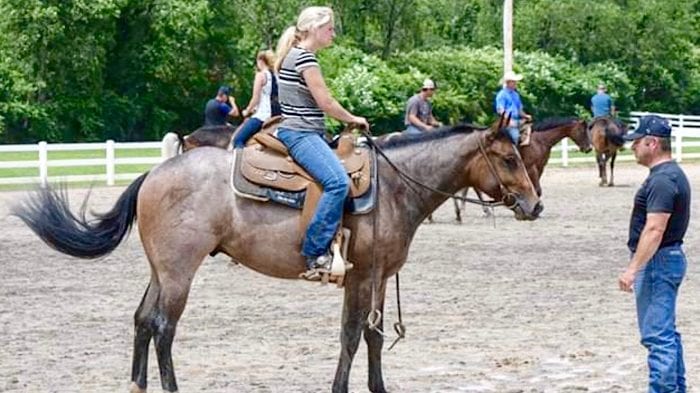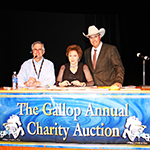Picture this: it’s your first day of kindergarten. You walk into a new school building that has busy halls full of other children and teachers. Some kids are crying and clinging to their mom or dad’s legs. Other kids wave, smile, and walk into the classroom with little fuss.
You join your class and begin to learn the days of the week, why two plus two equals four, and how to read and write. Your new environment is exciting and challenging; it is day one of the rest of your educational career.
As fall fades into winter each year, a similar phenomenon occurs for yearlings in countless barns across the country. In these barns, they, too, begin day one of their career as trustworthy partners for their future riders.
These first lessons are vital, and they can often be just as hard to teach as they are for the horse to learn. GoHorseShow had the opportunity to speak with trainers Mike Hachtel, Taft Dickerson, and Beth Case about the “dos and don’ts” of colt starting.
DO start with the basics
 Mike Hachtel has been starting two-year-olds since 1980 and has enjoyed success throughout his career, including a Reserve Congress Championship in the 2019 Masters Western Pleasure. We asked Hachtel about the first step to his starting process, and he told us that he first “takes thirty days to teach them stall life as opposed to run out life and to help get them into a little bit of a routine. I try to get them used to being handled – brushing them, getting them to go into a wash rack to wash their tails and their manes.”
Mike Hachtel has been starting two-year-olds since 1980 and has enjoyed success throughout his career, including a Reserve Congress Championship in the 2019 Masters Western Pleasure. We asked Hachtel about the first step to his starting process, and he told us that he first “takes thirty days to teach them stall life as opposed to run out life and to help get them into a little bit of a routine. I try to get them used to being handled – brushing them, getting them to go into a wash rack to wash their tails and their manes.”
By starting with basic handling, Hachtel says that you are “creating a connection” with the younger horses. Building a strong foundation of trust with your yearlings is of the utmost importance as you move forward in the starting process.
 When it comes to the first lessons in riding, it is just as essential to cover the basics. Beth Case, who has been starting horses for over twenty years, says that she “never asks for their face,” because, “they just need to learn where your legs are and how to stand up between your legs and reins.”
When it comes to the first lessons in riding, it is just as essential to cover the basics. Beth Case, who has been starting horses for over twenty years, says that she “never asks for their face,” because, “they just need to learn where your legs are and how to stand up between your legs and reins.”
Case emphasized the importance of being specific in your training of basic motions. “You need to start training them from day one. Their hip does not get to fly to the outside, teach them where their shoulders and their hips are from the start so that you don’t have to fix those things later,” she told us.
DON’T lose your patience
 Taft Dickerson, who has been starting horses for fifteen years, told us that the biggest mistake he sees others make throughout the starting process is rushing a horse, which results in “not having those basics because you tried to take a short cut and ended up leaving a part out.”
Taft Dickerson, who has been starting horses for fifteen years, told us that the biggest mistake he sees others make throughout the starting process is rushing a horse, which results in “not having those basics because you tried to take a short cut and ended up leaving a part out.”
When rushed through the first stages of the training process, a horse will inevitably come up with ‘holes’. Whether these holes present themselves outwardly or they are discreet and only surface in certain situations, they will undoubtedly come back to haunt that horse further down the road.
Hachtel explained, “Even if one horse isn’t doing everything as correct as another, you’ve got to recognize that he is still in control, and it might just take him a little longer to grasp it. There is no reason to put him in the penalty box. He might be the better horse at the end of the process, but he just wasn’t getting it on day one, two, or three. You don’t put him in the penalty box, and you don’t lose that horse’s confidence and that bonding.”
While it can be tempting to push a young, talented horse so that you can see the end result, you have to take into consideration how much you are asking of the horse. If the horse isn’t completely comfortable with step one, don’t move on to step two. It is vital to keep your patience throughout the process so that the finished product is the best that it can be.
DON’T forget to desensitize
 Nothing can be more frustrating to a rider than a ‘spooky’ horse. Dickerson says that the secret to what some may call a ‘bombproof’ horse is in the way in which it was started. He told us, “We do something that is probably a little different than most people. We teach them all to cross creeks and ride outside of our arenas. They can see everything. Imagine how much easier that makes it when you’re at a horse show. We try to teach the horses to be citizens, both inside and outside the pen. We want them to act like a somewhat-broke horse, even at a younger age.”
Nothing can be more frustrating to a rider than a ‘spooky’ horse. Dickerson says that the secret to what some may call a ‘bombproof’ horse is in the way in which it was started. He told us, “We do something that is probably a little different than most people. We teach them all to cross creeks and ride outside of our arenas. They can see everything. Imagine how much easier that makes it when you’re at a horse show. We try to teach the horses to be citizens, both inside and outside the pen. We want them to act like a somewhat-broke horse, even at a younger age.”
Exposing a young horse to unfamiliar objects, surroundings, or situations will not only desensitize him to new experiences, but it will also help build the trust that he has in his rider.
DO stay one step ahead
This one may seem like a no-brainer, but Mike Hachtel says that he finds it may be one of the most commonly overlooked aspects of the starting process by inexperienced individuals. He said that you should be, “aware of what could go wrong,” to avoid potentially dangerous situations. Even things as simple as “putting your toe in the stirrup and not your whole foot,” Hachtel says, can be the difference between success and danger. “The little mistakes can turn into a big mess,” he finished.
DO take it on a horse-by-horse basis
 Every teacher would testify that each student has a slightly different learning style. The same idea goes for horses. Beth Case said, “They’re all different. Some of them you can get on, and they’re broke in a week, but some may take three months to settle down and chill out. Don’t expect them all to be the same…you have to deal with each one differently.”
Every teacher would testify that each student has a slightly different learning style. The same idea goes for horses. Beth Case said, “They’re all different. Some of them you can get on, and they’re broke in a week, but some may take three months to settle down and chill out. Don’t expect them all to be the same…you have to deal with each one differently.”
Dickerson talked along similar lines, saying that even the preparation prior to the first ride “can be any kind of different thing.” He expanded on this, saying, “There are some that come from horse sales, and they’ve already had a lot done. They don’t take as much, they’re pretty easy just to get on. Then you’ve got some that people haven’t done a whole lot with. I’ve had ones that have been handled both ways. It all depends on the individual as to which approach works.”
The first days that a young horse is under saddle are just as exciting for members of the horse industry as a child’s very first day of school. Tomorrow’s world champions are today’s two-year-old prospects. We owe it to these horses to give them the best possible start to their, hopefully, long and successful careers as riding horses.









